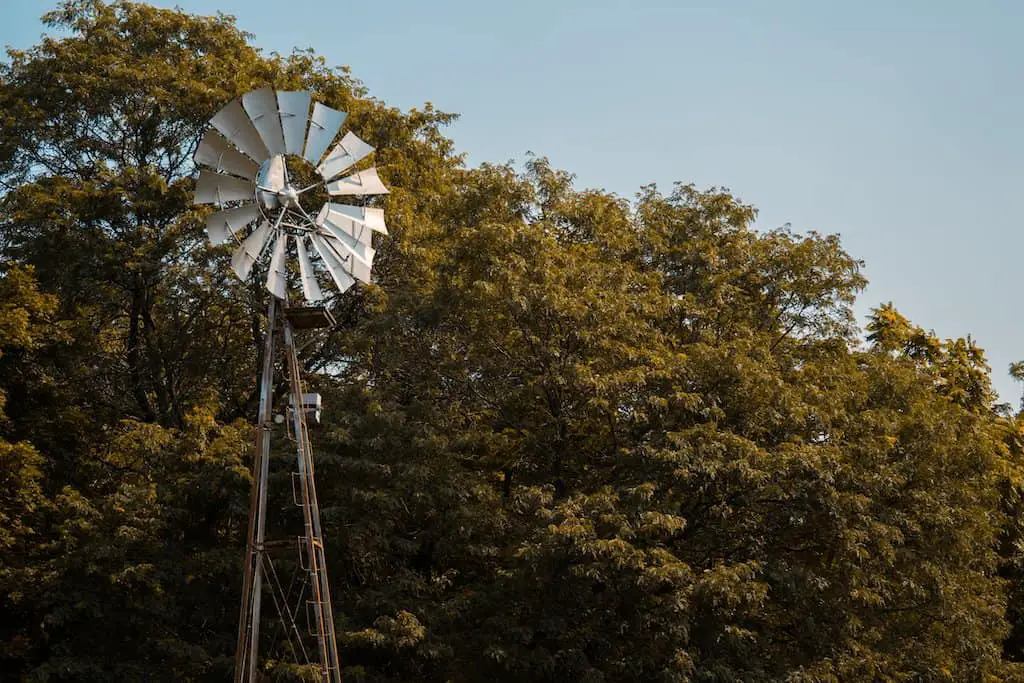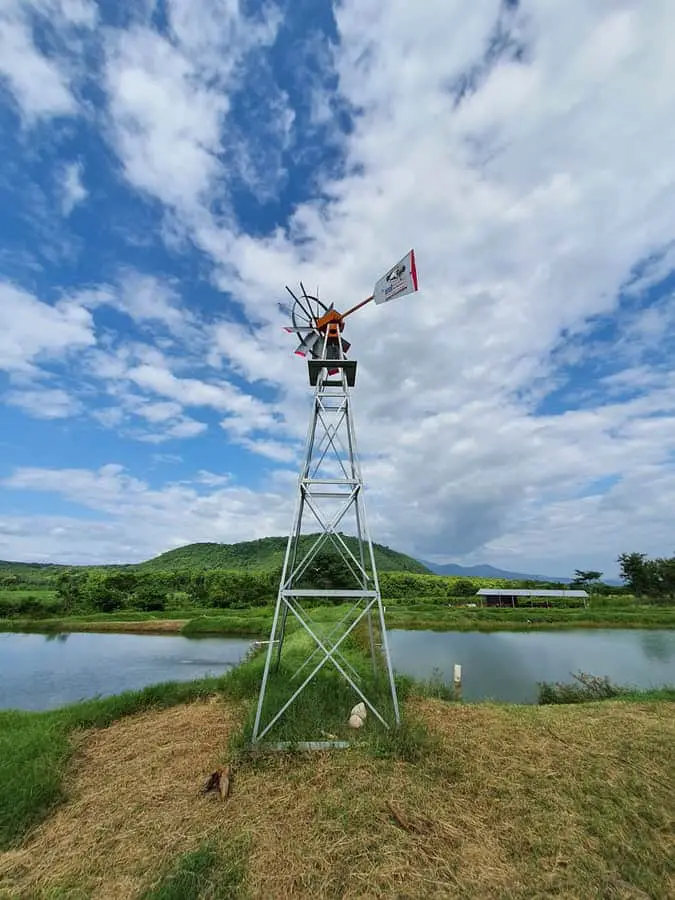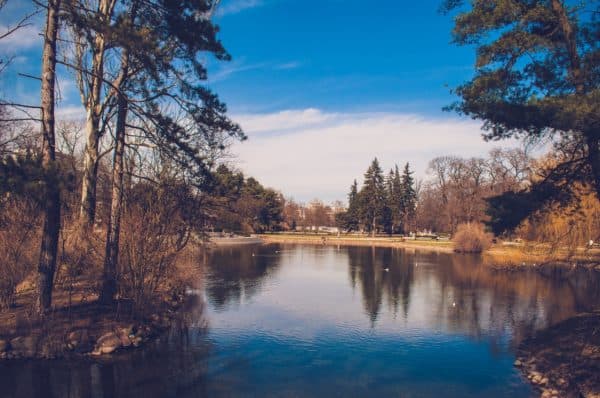Windmill pond aeration is the best solution to improve the quality of water in your rural pond. Simply put, water needs oxygen to keep ponds clean and preserve ecosystem equilibrium. We’ll explain how windmill pond aeration works, why you’ll benefit from it, its pros and cons, and some things to keep in mind when getting one.
This article will tell you important information about these energy-efficient means of pond aeration. We can say you’ll be blown away by the things you learn here!
Why You Need Windmill Pond Aeration
Oxygen is a natural cleaner— the key ingredient in maintaining water quality. To further explain: An oxygen-rich pond is more capable of getting rid of waste. The pond’s waste contains “deposits” from animals, such as fish and geese, and additional waste material that comes from stormwater runoff and animals and plants that perish in the pond. When it comes to breaking down waste and bringing it into solution, aerobic bacteria (oxygen-utilizing bacteria) perform almost 20 times faster than anaerobic bacteria. These broken down wastes can be flushed out or used to grow new life while in solution.
This maintenance system is operational all year round and provides your pond with a continuous oxygen supply.
During summer, oxygen is supplied by surface winds. However, these winds supply only the upper part of the water with oxygen. What happens is that the water separates into two layers and the lower layer remains suffocated.
The rising air bubbles of a bottom aeration system effectively move the water to the top. By aerating the pond’s bottom during the winter period, you allow continuous circulation and maintain a level of oxygenation that ensures fresh water all year round.
Windmill aeration is a cost-effective solution for providing bottom aeration to your natural bottomed, large pond, which will significantly improve your pond’s water quality.
Aeration will be beneficial to all ponds. Since all aquatic life use dissolved oxygen in surface water, oxygen levels are commonly used to determine the “health” of ponds.

What is Windmill Pond Aeration?
Windmill pond aerators can be your way of letting nature do all the work of aerating, circulating, and destratifying your pond.
Wind-powered aerators take the place of electric aerators, which can cost anything from thirty to fifty bucks a month to run. These windmills will pay for themselves in just a few years, and these are ideal for aerating faraway ponds without access to electricity!
Windmill aeration adds oxygen to all of the water, including the bottom. This is very important because once the lake has oxygen near the bottom, new larvae of insects, snails, fish, and beneficial bacteria can start living there.
For the past 20 years or so, the most typical windmill tower has been a three-legged, twenty-foot, galvanized metal structure. A 20-foot windmill’s average footprint varies between 84 and 100 inches, based on the specific model bought.
There are also four-legged windmills, such as the Outdoor Water Solutions Windmills and Mescan Windmills, that include a square-based footprint of varying sizes depending on the height required.
How Do Windmill Pond Aerators Work?
Bottom aeration is achieved simply by using air compression through an airline connected to an aeration diffuser at the pond’s bottom. The production of air bubbles at the bottom releases oxygen that moves the water from the deepest part of the reservoir up into the atmosphere.
Therefore, the large volume of water moved to the surface by increasing air bubbles makes the water remove toxic gases from the atmosphere, and the water picks up more oxygen while it is on the surface. Aeration accelerates the process of oxidation or burning of pollution in the water. The result is fresh, clear, and bright water with a sweet aroma that supports the abundant life of fish and eliminates algae and excessive weeds.

What Are the Types of Pond Aerators?
How else can you introduce dissolved oxygen into a pond? Some ways to do that are through wind, mechanical aeration, and diffused aeration.
The type of aeration used in a pond will directly impact the pond treatment process. What mixture of aeration methods depends on the form of a pond, organic loadings, surface area, and depth.
- Wind-driven surface aeration: when a breeze blows over the pond, oxygen is dissolved into it. This is a natural, small-scale version of mechanical agitation systems.
- Mechanical aeration systems disturb the water surface, making spray and waves, allowing oxygen from the air to be captured into the pond. Surface fountains, paddle wheels, and rotating brushes are examples of such mechanical machines.
- Diffused aeration is when a blower system is used to disperse air through the water. Fine bubbles are formed in the air stream; the smaller the bubbles, the more oxygen is transferred.
Solar Power vs. Wind Power for Aeration
Both wind and solar power are excellent choices for pond keepers trying to save bucks in the long run or if a remote water garden needs aeration. Despite both being renewable energy sources, their aeration capacity is not always comparable.
Solar energy, for example, is a much more readily available renewable energy source that is often less costly and simpler to install for standard garden ponds. Unlike the wind, which can be uncertain, you can usually rely on at least a little sunlight every day as long as trees don’t shade your solar panels.
If you don’t need a lot of aeration, a good solar-powered aerator might be a better choice than wind power.
Wind-powered aerators are unmatched in airflow vs. energy efficiency if you have a massive pond in a remote area. The top-of-the-line models can easily offer aeration at least six CFM suitable for ponds greater than 30,000 gallons or bodies of water larger than 1 acre.
You’d have to buy a much larger solar panel (which will set you back a great deal of money) to get something close to this level of CFM with solar power.
Not only that, but top-of-the-line solar panels also necessitate specialized repairs if they have problems, leaving you without aeration until you can hire a professional.
In contrast, you can easily manage windmills with a bit of DIY and a manufacturer’s extended warranty for repairs.

Advantages of Windmill Pond Aerators
Cost-effective, Renewable Energy
Wind power, like solar power, is an environmentally sustainable and green energy source that allows you to be entirely off the grid. You won’t need a power supply (electrical outlet), and the only expense would be the original buying price, which will save you a lot of money in the long run.
Getting Rid of Algae
Aeration reduces algae growth by removing their food (nutrients), nitrogen, ammonia, and soluble phosphates from the surface and out of the pond. Iron and manganese oxidize and leave the solution at the pond’s bottom. Once the oxidation of these metals begins, they no longer dissolve again.
Aeration increases aerobic bacteria that consume the other nutrients that algae and weeds need to grow. Aerobic bacteria eat these foods before weeds and algae can, forcing them to starve and die.
Aerobic bacteria are the good guys: they breathe in oxygen and breathe out CO2 like us. They have a massive appetite for devouring any organic item. Aerobic bacteria begin to eat the organic sediment at the bottom of the pond and continue to eat as long as they are given oxygen.
The more aeration in the winter, the fewer algae in the summer.
Removes Unwanted Waste and Odors From the Pond
Aeration also removes ammonia, hydrogen nitrate and sulfide gases, and foul odors from the pond. These chemical compounds are the byproducts of natural biochemical processes in living organisms.
Potential for Massive Aeration (Airflow)
Wind-driven aerators are highly suited for generating a good amount of airflow, which can oxygenate waters ranging from one to twelve acres. Smaller aerators can oxygenate koi ponds in the garden, while higher-end models can aerate even the most extensive natural ponds.
It’s possible to install it in a remote area.
Windmill aerators can be positioned entirely off the grid—in fact; they work optimally in this setting.
You’ll need as much exposure to air currents and as much height as possible to get the most power out of your windmill. This requires minimum obstructions—two aspects that a remote installation will always offer.
Disadvantages of Windmill Pond Aerators
It can be unsightly in your landscape.
Windmills will undoubtedly stick out in your landscape, especially if the area is small. Be prepared for a change in the pond’s surrounding area’s aesthetics if you want to get a windmill pond aerator.
Furthermore, many neighborhoods might not allow them, so they are likely only suited to rural or industrial settings.
Unpredictable
The disadvantage of windmill pond aerators is that the air pump compressor is driven by wind. Most windmill aeration systems can work with wind speeds as low as five miles per hour, but if the wind is slower than that, there will be no aeration.
Well, what can you do about it?
Depending on your pond’s size and depth, a wind and solar power mix could be the best choice. When the wind blows, a wind-powered option will provide the aeration and oxygen, and in less windy conditions, a solar-powered pump will provide the backup aeration. Both are environmentally safe and cost-effective ways to aerate your pond, and neither uses electricity.

Things to Consider When Choosing Wind-Powered Pond Aerators
These are some things to keep in mind when you’re about to purchase a windmill pond aerator.
Airflow & Aeration Potential (CFM)
Ensure the windmill you buy will give the right amount of airflow (oxygen) for the amount of water you have. If this will be your primary source of aeration and you don’t have a backup system, we still suggest getting a slightly bigger model that can deliver more CFM even in low wind conditions.
The air volume that can come from a pressurized storage container using an air compressor is measured in cubic feet per minute (CFM). Top-of-the-line wind-driven aerators would be capable of producing at least three CFM of airflow, which will be sufficient for ponds larger than an acre or with a capacity of 30,000+ US gallons.
Also, realize that you may need more than one bottom diffuser if your pond is not circular. Bottom aeration works best in deep, circular ponds. The deeper the pond, the more pressure it will take to push air to the bottom, so you will need to check the psi rating on your windmill. Diffusers are more effective in deeper ponds because the air bubbles spread out wider in the water column as they raise to the surface, turning more water.
If your pond is more shallow or you have an oval or oddly shaped pond, you may want multiple diffusers to be sure that you are turning the water sufficiently.
Height of Tower & Blade Length
Windmill aerators come in many sizes, from nine-foot towers for backyards to larger than 30-foot towers for big outdoor ponds. Finding a sweet-spot for optimal aeration is critical because air currents’ intensity increases with height when there are fewer ground-level blockages.
For instance, if you’re putting a smaller tower in your garden and have a seven-foot-high enclosing wall, you’ll need a tower that’s at least seven feet tall to capture upper-level air currents. This is why windmills are very well fitted to remote sites, where height is less of an issue, and you can go even bigger to improve aeration capacity without bothering the public.
So, what’s the sweet spot for height? The head of your windmill needs to be higher than any visible barriers and as far away from structures that would possibly impede incoming winds.
Additionally, you can also consider the tower head where you’ll find the moving blades—the bigger the blades, the more energy you’ll produce. However, you’ll need significantly more wind, as a general rule.
If your blades are too big, they’ll need lots of wind to work and might even stop working entirely in light winds. Similarly, if they’re too small, they may not be able to generate enough energy to allow for proper airflow.
While fan head sizes vary by manufacturer, for higher remote towers, we suggest a fan head size of 60-80 inches, and for backyard towers, a fan head size of 30-60 inches.
Bearing Fatigue and Reliability
Bearing fatigue is the primary weakness of wind-driven windmills and turbines. This is a problem for all existing turbines around the world!
Bearings support the turning shaft that the turbine’s blades are attached to. You can expect bearings to last around ten years until you need to replace them. And larger bearings usually last longer than small pieces. If you’re lucky (or you nailed the installation and maintenance), they can last twenty years.
But you should understand that larger bearings decrease total machinery reliability by increasing friction, whereas smaller bearings are more efficient but can fatigue faster.
Take your time to research windmill manufacturers and find one with a good track record of bearing stability and durability. Make sure the windmill is engineered against bearing fatigue, which ensures bearings have been custom sized for that model for greater durability.
As with purchasing any large piece of equipment, it is advisable to find a manufacturer with a good reputation for customer support, and that has experts who are willing to help, should you run into trouble in the future or if you have questions during installation.

FAQ About Windmill Pond Aeration
What are possible problems you can have with windmill pond aeration?
It changes the overall look of your landscape.
One of the most glaring issues that can arise after installing a windmill pond aerator is transforming your landscape’s general appearance. Windmills need complete access to the wind for peak efficiency, which implies a windmill would be the most prominent element of your landscape. A windmill would better blend in larger landscapes since there is more space for other features.
Stormy weather
Although windmills are built to harvest the wind’s energy, too much wind will destroy and ruin them. Extremely strong gusts can endanger the windmill and residents in the surrounding area, as dropping blades can be fatal. Checking the windmill pond aeration system’s wind rating will help you avoid damage from storms and strong winds.
Insufficient wind
One of the most serious issues with a windmill pond aerator is that it operates only when there is wind. Because of this, windmill aerators can only be used in locations where there is a consistent supply of wind. You can go with mechanical or electric aerators for better pond circulation if it is located in a low-wind environment.
Clogs
Similar to other forms of pond aeration, the windmill pushes air through tubes that feed the diffusers. Debris and particulates present in the pond water may clog this diffuser, as well as the tubing that feeds it, over time. Cleaning is expected regularly to ensure that the air supply system is in good working order.
Leaks
Animals, and other general wear and tear, can cause aeration tubes to leak in a windmill aerator. A leak reduces the pressure pushing air into the airline diffuser, which decreases the amount of oxygen incorporated into the pond. Leaks may be reduced by burying or sealing above-ground parts of aeration tubing.
What size of windmill compressor is right for my pond?
Like electrical aerators, you’ll want to ensure the optimum CFM of a windmill aerator is appropriate for the scale and volume of your pond. Blade length and tower height are critical factors to consider, but they won’t matter if your aerator doesn’t supply enough air circulation for your pond.
While there is no definite formula for measuring CFM to water volume, the list below gives a rough guide.
- 1000-4000 US Gallons: 0.50-0.80 CFM
- 4000-8000 US Gallons: 0.80-1.20 CFM
- 8000-16000 US Gallons: 1.20-2.00 CFM
- 16000-32000 US Gallons: 2.00-4.00 CFM
- 32000 US Gallons or more: 4.00 CFM and more
Is wind power acceptable for backyard ponds?
Wind power is ideal for huge open areas where you can catch lots of air currents without being obstructed by walls, trees, or nearby structures since they can quickly minimize winds. Installing turbines in backyards has the downside of needing additional height for maximum airflow, which can turn them into an unsightly feature in your landscape.
There are smaller-scale windmill solutions available that can provide aeration even without much height if you’re trying to push aeration for a smaller pond and don’t need huge air pressure quantities. Some of these are repurposed ornamental windmills attached to an aeration device to provide adequate airflow for backyard ponds.
That being said, a word of caution: any form of turbine aerator is far more challenging to set up than a solar-powered or electric-powered aerator. To complete the extra measures required to get the equipment together and in proper working order, you’ll need some DIY experience.
What about low wind speed conditions? Will I still have aeration?
Wind-driven pond aerators typically do not have any backup, so you have no aeration if there is no wind.
There are ways to combine electric and windmill aeration systems so that you can have the electric aerator work if the wind stops, but this would require access to electricity.
If you have a pond that needs continuous aeration, such as a giant koi pond, a backup aerator is often recommended in case the primary one fails. A standard electrical aerator can be kept on hand to use as a manual backup device should your primary aeration fail.
A healthy pond will not deteriorate quickly if the wind stops blowing for a bit. The real concern would be that if you are in a hot location, your pond is shallow, and you have many fish, the warm, shallow water would not hold much oxygen for the fish if the windmill stopped for a long time.
If you don’t have access to a power supply, a solar-powered device can be used as a backup to a wind-powered system – but depending on the size of your pond, this may be very costly.
But don’t worry: even in extremely low wind conditions, the top-quality windmill models will still have excellent air capture. In conditions with winds as low as seven to ten MPH, most will manage to provide aeration, albeit at a decreased rate.
Your windmill’s minimum running speeds are a significant measure of efficiency since better-optimized blades and designs can generate power even in low pressure.
Conclusion
Hopefully, this article has helped to inform you about windmill pond aeration. If you have a large pond that does not have electricity nearby and you live in a rural area, then windmill aeration might be perfect for you.
Pond aeration is the single best thing you can do to improve your natural bottomed pond’s water quality, so installing a windmill will definitely help. Windmill aeration is also safe and very eco-friendly, so not only are you helping your pond, but you are also helping the environment.
REFERENCES
[1] Usgs.gov. 2021. Dissolved Oxygen and Water. [online] Available at: <https://www.usgs.gov/special-topic/water-science-school/science/dissolved-oxygen-and-water> [Accessed 17 March 2021].
[2] Michiganseagrant.org. 2021. Dissolved Oxygen and Lake Stratification | Teaching Great Lakes Science. [online] Available at: <https://www.michiganseagrant.org/lessons/lessons/by-broad-concept/physical-science/dissolved-oxygen-and-lake-stratification/> [Accessed 17 March 2021].
[3] Clemson.edu. 2021. Aeration, Circulation, and Fountains | College of Agriculture, Forestry and Life Sciences | Clemson University, South Carolina. [online] Available at: <https://www.clemson.edu/extension/water/stormwater-ponds/problem-solving/aeration-circulation/index.html> [Accessed 17 March 2021].
[4] Module 19: Treatment Ponds And Lagoons. 2021, https://files.dep.state.pa.us/Water/BSDW/OperatorCertification/TrainingModules/ww19_ponds_wb.pdf. Accessed 17 Mar 2021.
[5] “Windexchange: Small Wind Guidebook.” Windexchange.Energy.Gov, 2021, https://windexchange.energy.gov/small-wind-guidebook.
[6] “Pond Ecology.” Penn State Extension, 2021, https://extension.psu.edu/pond-ecology. Accessed 19 Mar 2021.
[7] Glaze, William H. et al. “The Chemistry Of Water Treatment Processes Involving Ozone, Hydrogen Peroxide, And Ultraviolet Radiation.” Ozone: Science & Engineering, vol 9, no. 4, 1987, pp. 335-352. Informa UK Limited, doi:10.1080/01919518708552148. Accessed 19 Mar 2021.
[8] “Iron And Manganese In Private Water Systems.” Penn State Extension, 2021, https://extension.psu.edu/iron-and-manganese-in-private-water-systems.

